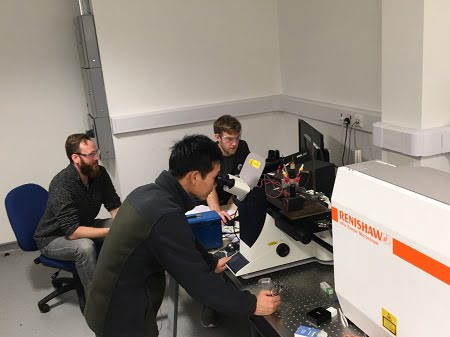
Renishaw Microscope Used for Energy Storage Development at U. Liverpool
WOTTON-UNDER-EDGE, England, Jan. 24, 2018 — The inVia confocal Raman microscope from Renishaw PLC is being used by a team at the Stephenson Institute for Renewable Energy at the University of Liverpool to develop energy storage devices.

Professor Laurence Hardwick and colleagues use their Renishaw inVia Raman microscope to perform operando electrochemical measurements. Courtesy of Renishaw.
The team, headed by Laurence Hardwick, is investigating the reaction mechanisms that lead to surface layer formation and identifying the species that form these layers. These mechanisms influence the performance and safety of both metal-air and lithium-ion batteries. They use a range of in situ analytical techniques in IR spectroscopy, x-ray photoelectron spectroscopy (XPS), UV-VIS and Raman spectroscopy. IR spectroscopy allows the team to investigate the mechanisms that lead to electrolyte decomposition during attack by the superoxide species formed during oxygen reduction in lithium-air batteries. They use XPS to study the chemical elements present in the top few nanometers of the electrode surfaces, their quantities and oxidation state. They determine the electronic state of reduced oxygen species, which can adversely affect device stability, with UV-VIS spectroscopy. Raman spectroscopy is a particularly powerful technique for this application.
Hardwick’s group uses the inVia confocal Raman microscope to nondestructively study the electrode through the electrolyte with high spatial resolution and sensitivity. The device uses an inverted microscope configuration which makes it easy to analyze working electrochemical cells to identify intermediate species in reactions and study phase changes. They also get valuable information from ex situ Raman mapping measurements. For example, they identify the different discharge products produced on cathodes and determine their distribution.
The inVia has helped the team better understand the oxygen reduction reaction and oxygen evolution reaction mechanisms, along with the intermediary species that are formed. They use surface-enhanced Raman scattering to amplify the electrode surface spectra while electrochemically cycling the cells.
Renishaw is an engineering and scientific technology company focused on precision measurement and healthcare.
/Buyers_Guide/Renishaw_PLC_Spectroscopy_Products_Div/c12692